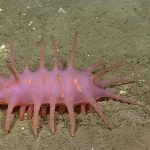The NOAA Ship Okeanos Explorer had an amazing dive March 9, 2017 on Pao Pao Seamount, an underwater mountain in the Tokelau Seamount Chain in the South Pacific. Continue reading The Scintillating Sea Life of Pao Pao Seamount
All posts by Holly Morin
March 2017 Newsletter
Hello Ocean Explorers:
We are pleased to announce the launch of our Northwest Passage Project’s website, www.northwestpassageproject.org. The Northwest Passage Project (NPP), an innovative science and education initiative that includes an expedition into the Canadian Arctic Archipelago. This National Science Foundation (NSF) funded project will engage intergenerational cohorts of high school, undergraduate, and graduate students in hands-on research exploring the changing Arctic and collecting data.
Weekend Discoveries
The NOAA Okeanos Explorer visited two seamounts in American Samoa over the weekend. During these dives, the team on board found some great biology:
Image courtesy of NOAA Office of Exploration and Research
2016 – A Year in Review
It’s been another eventful year here at the Inner Space Center (ISC)! We outfitted two research vessels and a merchant vessel with telepresence technologies, and supported over 100 days of telepresence on the E/V Nautilus, and on the NOAA Ship Okeanos Explorer. Our services facilitated the investigation the El Faro shipwreck, supported a 5-year study of submerged tribal cultural sites in Rhode Island Sound, and enabled the first ever telepresence broadcast from a manned submarine! During the summer, we hosted the next generation of deep-sea scientists at ISC Mission Control as they participated in a Woods Hole Oceanographic Institution (WHOI) dive-planning boot-camp. Meanwhile, the Nautilus and Okeanos Explorer continued their ground-breaking deep sea explorations of offshore California, and the Marianas region.
Continue reading 2016 – A Year in Review
Northwest Passage Project
The Northwest Passage Project (NPP) will explore the changing Arctic environment during an innovative expedition that will engage diverse audiences through real time interactions from sea, an ultra-high definition 2-hour documentary, and related community events.
Funded by the National Science Foundation, the NPP is a collaborative effort between the University of Rhode Island (URI) Inner Space Center (ISC) and Graduate School of Oceanography (GSO), the film company David Clark, Inc., and several other collaborators, including six U.S. Minority Serving Institutions (MSIs) and the tall ship SSV Oliver Hazard Perry (OHP).
Two cohorts, each consisting of 18 students (six high school students, nine undergraduate students, and three graduate students), will sail on board the SSV Oliver Hazard Perry for 2-2.5 week legs. These students will receive science content instruction as the ship is underway, gain navigation and sailing skills, engage in hands-on projects while aboard and during site visits on land, and contribute to live broadcasts from the Arctic.
The student participants will be sailing on the OHP, the first ocean-going, full-rigged tall ship built in the U.S. in over 100 years. The students, scientific party, film crew, and ship’s crew will journey through the Arctic’s Northwest Passage in August of 2017.
For more information on the NPP, please read a recent press release.
Creature Spotlight: Dancing, Flailing Sea Cucumbers
Among the most sighted organisms during the field season’s remotely operated vehicle dives are sea cucumbers, also known as holothurians. A class containing over 250 species, sea cucumbers are highly diverse, and may appear spiky and brightly colored, or smooth and translucent.
The Nautilus Live video below , and this video by the NOAA Ship Okeanos Explorer team showcase the extraordinary diversity of sea cucumbers encountered in Windward Passage, and the Marianas, respectfully.
more info…


Featured image: Sea cucumber off the coast of Puerto Rico, 15 October, 2013. Image courtesy of the Ocean Exploration Trust.
Rediscovering History: the USS Independence
Thirty miles off the coast of San Francisco, CA, at 793 m (2,600 ft) depth, lies the watery grave of the decorated United States aircraft carrier, Independence. Continue reading Rediscovering History: the USS Independence
Rediscovering History: Wake Island Atoll
On December 8th, 1941, shortly after the World War II attack on Pearl Harbor, thirty-six Japanese, Mitsubishi G3M2 Nell bombers appeared in the skies above Wake Island Atoll. A battle ensued. Continue reading Rediscovering History: Wake Island Atoll
Okeanos Explorer Dives on Pearl Harbor Mini Subs
On December 7th, 2016, the NOAA Ship Okeanos Explorer dove on two Japanese mini-subs that sank 75 years earlier, during the attack on Pearl Harbor. The USS Ward fired the first shot of the Pacific War, sinking this submarine 90 minutes before the air raid on Pearl Harbor. This attack marked the introduction of the United States into World War 2. Highlights from the dives on these submarines can be viewed below:
More photos and illustrations of the mini-subs and the USS Ward are available on the National Marine Sanctuaries website.
Be sure to check for updates on the upcoming field season on the Okeanos Explorer Home Page, the Nautilus Live Homepage, the Inner Space Center website, and on our Facebook and Twitter pages!
Cool highlights from the 2016 field season (like this ghost catshark) are available on our YouTube channel!
Featured image: Conning tower of Pearl Harbor Mini Sub. Image courtesy of NOAA Office of Exploration and Research, 2017 Shakedown Cruise.
New Year, New Field Season!
The NOAA Ship Okeanos Explorer‘s 2017 field season will kick off January 18, 2017, with a mapping expedition from Honolulu, Hawaii, to Pago Pago, American Samoa. This field season marks the third year of CAPSTONE, the Campaign to Address Pacific Monument Science, Technology, and Ocean Needs. The goal of which project is to collect data necessary to support science-based decision making for marine protected areas (MPAs) in the central and western Pacific. Continue reading New Year, New Field Season!























